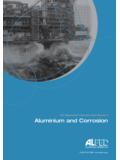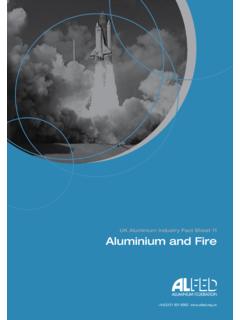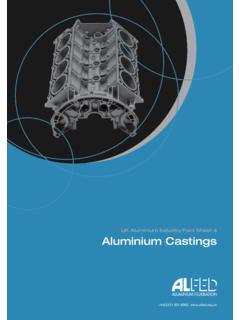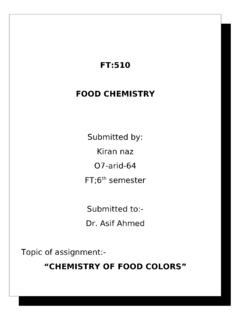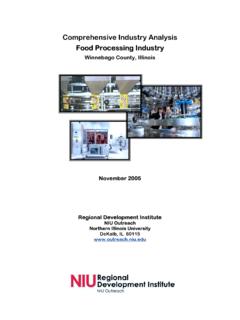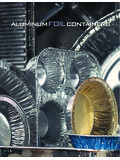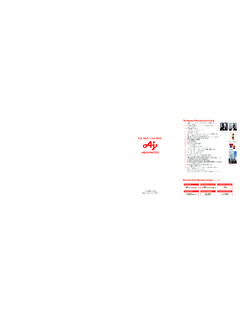Transcription of UK Aluminium Industry Fact Sheet 15 Aluminium Packaging
1 UK Aluminium Industry fact Sheet 15 : Aluminium Packaging1 Aluminium PackagingUK Aluminium Industry fact Sheet 15+44(0)121 601 6363 UK Aluminium Industry fact Sheet 15 : Aluminium Packaging1 Introduction At 8% Aluminium is the third most common element in the earth s crust; only oxygen and silicon are present in greater proportions. Aluminium is found in nature as stable alumino-silicates. A complex extraction and primary smelting process allows the production of Aluminium in its metallic form. Then, when suitably alloyed and with various semi-fabrication processes such as rolling, extruding and forging, a whole spectrum of physical and mechanical properties become available. These properties have led to the extensive use of Aluminium in various end markets such as Packaging . Most of the Aluminium used in Packaging is in the form of rolled products, either as flexible Packaging , such as fine foils, or as rigid Packaging , such as the beverage can.
2 These attractive properties of rolled Aluminium used in Packaging can be summarised:(1) Durability and StrengthAluminium foil is commonly produced in the 1000 series alloys, alloyed only with iron and silicon. These alloys work harden when subject to cold deformation. The thickness (gauge), alloy and temper can be chosen so that the exact properties required can be achieved. Stamped foil containers therefore retain their shape and rigidity.(2) LightnessThe low density and thinner sections of Aluminium compared with some competing Packaging materials means a reduced weight, saving energy in transport.(3) Thermal ConductivityAluminium is an excellent conductor of heat and therefore the chilling and heating of the contents of Aluminium Packaging can take place quickly, with minimal thermal gradients.(4) Heat ResistanceAluminium Packaging resists a very wide range of temperature, from the very cold to the very hot.
3 There is no risk of cracking, melting or burning. Aluminium Packaging products can be stored in the coldest deep freeze and heated in the hottest oven.(5) Barrier PropertiesAluminium foil acts as a total barrier to light, gases and liquids and can extend the useful life of foodstuffs for long periods of time, measured in years, adding value far beyond the cost of the Packaging material.(6) Food and Drink CompatibilityThe vast majority of foods and drinks have no adverse effects on uncoated Aluminium , so there is no contamination. With very acid or alkali ingredients a wide range of food-contact coatings are available affording full protection to the contents of the foil Packaging or the can.(7) Decorative PotentialAluminium foil and can stock is compatible with all printing processes so that the contents of the foil or the can can be attractively presented.(8) Foil LaminatesAluminium foil can be laminated to produce tough Packaging systems that withstand rough handling in the distribution chain.
4 (9) Sustainability of Aluminium PackagingThe use of Aluminium Packaging saves food wastage and saves energy in transport. The Aluminium can be recycled after use repeatedly with no loss in quality. The current recycling rate of the Aluminium beverage can in the UK is 42%. The high value of Aluminium in the waste stream means that it is economically viable as well as environmentally advantageous for Aluminium Packaging products to be removed from the waste stream for recycling. Local Authorities can raise revenue from collecting Aluminium from the waste stream, subsidising less valuable materials. Schools and charities can raise funds by arranging to collect Aluminium foil and beverage cans for recycling. UK Aluminium Industry fact Sheet 15 : Aluminium Packaging2 The Process(1) Aluminium Foil used with Meat, Poultry and FishAluminium foil is widely used in the Packaging of fresh and processed meat, poultry and fish.
5 The customer requires and gets convenience, coupled with dependable quality and complete hygiene. Retailers have discovered the advantages of ready-to-cook packs containing trimmed fresh meat and poultry cuts and fish in sealed Aluminium foil containers. Aluminium foil is successfully used for processing and marketing p t s and other prepared meat recipes.(2) Preserved FoodsExtending the viability of seasonal foodstuffs has a long history. Techniques of food preservation have evolved conserving the nutritional value and flavour of the food concerned and the investment of labour and energy. While traditional Packaging materials such as glass jars and metal cans are still used, light weight pouches, foil containers and laminated cartons offer the same performance with much less weight.(3) Dehydrated and Dry FoodsDrying as a technique for food preservation is a very old process that is still widely used today.
6 Once the foodstuff is protected from light and gases the dried food retains its nutritional value and texture until re-hydrated. Aluminium foil provides the essential barrier to completely and reliably prevent ingress of moisture and the escape of subtle flavours. It also prevents UV light, present in most forms of lighting, from causing photo-oxidation leading to a rancid taste from fat and oil components in dried food foil in the form of sachets is widely used to pack such food items as milk and soup powders, herbs and spices, instant beverages and vegetables.(4) Aluminium Beverage CansThe Aluminium beverage can is now the popular choice for carbonated and still soft drinks, mineral waters, beers and lagers. It competes successfully against drinks containers of glass, plastic and steel, and is the only drinks container for which closed loop recycling applies; a used Aluminium drinks can is recycled back into Aluminium can Sheet for the manufacture of another Aluminium drinks can.
7 The good thermal properties of Aluminium mean that the drinks can is quickly chilled. It has good rigidity and strength without the grave disadvantages of a glass bottle, of being fragile and dangerous when broken and much heavier than an Aluminium can. It is lighter than steel and even a steel beverage can relies on Aluminium for the top of the can since the better control on gauge and properties of Aluminium mean that the easy open end of the can can only be made in compatibility and hygieneThermal conductivityHeat resistanceDurabilityMulti-mode cookingDecorative potentialLightness and space economySustainability Ready-to-roast and in-store Packaging of fresh products Smooth wall containers for processed meats pouches and sachetsPeel-off closures for alu, plastic or tinplate containersKey: Essential / Important Advantageous UK Aluminium Industry fact Sheet 15 : Aluminium Packaging3 Even though Aluminium has a low specific gravity, the Aluminium Industry has worked hard to reduce the gauge of the can, and hence the weight, while improving the mechanical properties so that the thinner material making the can still carries out all of the requirements of a Weight per Aluminium CanMore information particularly about Aluminium Packaging can be obtained from European Aluminium Foil Association and Alupro information about Aluminium and Aluminium alloys, their production, fabrication and end use can be obtained from:(1) European Aluminium Association in (2) International Aluminium Institute in London 02468101214161820grams/can19831987199019 93199720002003source: BCME
